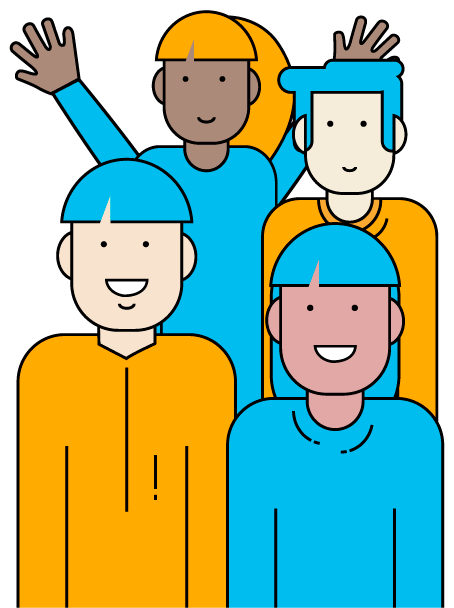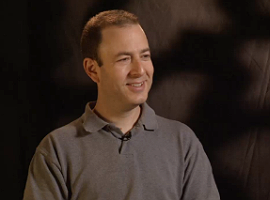Categories
Gil Broza: How to Transform Management Into an Effective Team in No Time?
Richard Kasperowski interviews Gil Broza. Gil is a mindset and leadership coach. He is well known for his books: The Agile Mind-Set and The Human Side of Agile. Recently, he authored a third book – Agile for Non-Software Teams, so our conversation went in that direction. We explore if it is possible for the managers – those well-known turf warriors and individualistic giants – to get together and perform as a homogenous team. When you finish listening to the episode, make sure to connect with Gil on LinkedIn and visit his website at https://3pvantage.com, where you will find tons of free resources.
Gil Broza: How to Transform Management Into an Effective Team in No Time?
with Gil Broza


TRANSCRIPT
Richard: (00:11) Hi friends. Welcome back to With Great People, the podcast for high performance teams. I’m Richard Kasperowski. In this episode, I talk with Gil Broza, a mindset and leadership coach. Gil is the author of The Agile Mindset and The Human Side of Agile. His latest book is Agile for Non-Software Teams, and so we focus on non-software teams in our conversation. We explore what makes management teams exceptional, can management really act as a team, what tears management teams apart, and what brings them back together? To support this podcast, visit my website, kasperowski.com.
Richard: (00:58)
Today, we have Gil Broza with us. Hi, Gil, how are you?
Gil: (01:02)
Awesome, how are you?
Richard: (01:03)
Great. Will you introduce yourself to our listeners?
Gil: (01:05)
Sure. I have been involved in agile work for almost 20 years now. I used to be a developer, I was manager, I was a software architect. And about 15 years ago I got into XP coaching at the time, when XP stood for Windows XP, but … our kind of XP. And yeah, I’ve been working with dozens of companies. It’s coming on my, I think I’d say, 100 companies or so far.
Richard: (01:29)
Wow.
Gil: (01:30)
Yeah, that are interested in becoming more agile. And I work with teams, I work with management, I work with product, and more recently with non-software teams. So really I work across and up. All so, that the organization can achieve better outcomes with happier people.
Richard: (01:50)
All right. So around 100 organizations now. And in the past many years out of all these organizations, out of all these teams you’ve worked with is there one that you could think of as the best team you’ve ever worked with, or the best team you’ve ever been part of?
Gil: (02:06)
So I had some time to think about this question ahead of time and I really struggled to find the one best team. And then, I realized that one reason I struggled to do that is the nature of my job. So, I get called in to help when either they’re starting agile, or they are restarting it because it got broken, or they’re kind of fixing and improving. And so people won’t pay for consultants when things are great, right? And so the teams I see when I come in are all over the spectrum of greatness.
Richard: (02:43)
Okay.
Gil: (02:45)
Well, so here’s the deal you can’t really have great agile without a great team. If you have a great team, you might still have terrible agile, right? So my work is just on the team side. Yes, I wrote The Human Side of Agile, but it’s not the only thing I do. A lot of times the problems really can be anywhere. Sometimes it’s the team, sometimes it’s the overall organizational framework. It can be culture, it can be technical limitations that are killing them. It could be anything. With that said, it’s not common that I come in and the teams are already doing great, but it’s the management system that needs help.
Richard: (03:28)
Okay.
Gil: (03:29)
So in trying to think about which team, I really considered a great team I thought I would talk about a management team. So maybe that will give you a bit of variety for the podcast, so it’s not just the teams themselves, right?
Richard: (03:44)
Yeah, that’s perfect. So, tell us more about this management team.
Gil: (03:48)
Yes. So they work in a department that is in charge of the digital presence of the organization. There’s been a digital transformation and this and that, fairly substantial group. So when I came in the digital department had, I’d say, close to 100 people and nowadays they’re easily 50% bigger than that. And I got to be with them a couple days a month over more than three years. And that is a relatively flat department. So it’s inside of a much bigger, more traditional organization, but the department itself is fairly flat. So I would say that between the senior director that’s in charge of it to line workers there’s usually only one person, in some cases there’s two.
Richard: (04:40)
Wow.
Gil: (04:40)
So fairly flat.
Richard: (04:41)
That’s a huge span of influence for the people who are in charge.
Gil: (04:46)
Absolutely. And, to be fair, it worries them, and sometimes they feel overwhelmed and overworked. And part of what I’ve been helping them do is really how to scale leadership without adding boxes on the org chart.
Gil: (05:03)
The way they’ve been organized, there’s a whole bunch of teams, it’s not quite a scaled situation. And whatever scale they have had is totally organic, they’re not using any framework. There are dependencies between the teams. There is some cross collaboration between the teams, but it’s not like this huge program where everybody has to be marching at the same cadence or things just break down.
Gil: (05:28)
So, the managers, for the longest time, were in charge of functions. The traditional way we graphed agile onto the org structure so you had this person would manage this many devs, and this person would manage this many QAs, and so on. And about, I forget exactly when, but I’d say about a couple years ago they actually switched that. So now the same managers are in charge of whole teams. There is still some kind of functional oversight. There is a couple more directors, previously they didn’t have them, but by in large managers there have a span of influence that corresponds somehow to the value stream, which is really awesome.
Gil: (06:11)
And they have been working as a management team to fundamentally improve the culture. So yes, they want agile and the culture they want is kind of informed by agile, but everything they do really comes from the perspective of enabling the workers with the highest level of autonomy that this organization can muster. And as much as they can in terms of reducing friction in the system. So in the early days that I worked with them, they would have this type of backlog that they worked through, and the backlog had some things to do with the move to agile, and some things in terms of setting things up and, just as an example, helping create some more good practice and tooling around continuous deployment.
Richard: (07:02)
Sure. This is the management team’s backlog?
Gil: (07:05)
Yes. What I saw though in the last couple years, especially since there was upgrade in how teams were working, so they were not just going through this promotions anymore they were really being agile is that the management team was really focusing on the high value add things that crossed the department that helped with even getting into more agility in terms of the hiring, and even the seating arrangement, and technical agility, planning, any time they engage more people in continuous improvement, things like that.
Gil: (07:50)
And nowadays, the team is about 15 managers, many of them are called managers, and the other ones are directors. So there’s a couple there that report to others. It hasn’t always been smooth. It is definitely a large team. What I’ve been focusing a good deal of my involvement on is how to support them in continuing to be like that, again, without solving it with hierarchy. And one thing that I really liked, and this would be, I suppose, a good recommendation for other people who have this type of situation, is that a year ago they noticed that they weren’t aligned as much as they wanted. And they asked me to facilitate a session for them to really realign them.
Gil: (08:36)
And I remember we were calling this renewing our vows. And it really took them through what’s our mission as a management team, not as the organization, or the department, but our management team’s mission. What are our values, right? And what sort of working agreements can we make so that we manifest our values, and actually get great results? And, just as an example, one of the working agreements had to do with how they made decisions, and how they pursued opportunities because up to that point they were really big on consensus. So they would have lots of meetings and everybody would be heard. And lots of stickies, right? And all of that. But everything felt kind of slow because they wanted everyone heard and participating. And that is terrific. And it was important, but they realized it was also slowing them down.
Gil: (09:29)
And so one of the new working agreements had to do with distinguishing for each opportunity what type of decision making it should have. Should it involves everyone, is it okay to simply have a small group of interested people just take charge and run with it? And that gives them everybody else’s blessing. Is the decision they’re looking at something that does require running it by the department head, and so on. And that was another way that helped them scale up, again, without adding more intermediate levels.
Richard: (10:01)
Okay. Let’s pull back a little bit. So thinking back about this best team ever, this management team summarize all of their goodness, or the sensation of being with them, and doing the work with them. Can you summarize all that in one word?
Gil: (10:19)
Ooh, okay. Generally, I cannot summarize anything in one word. I write books. How would I summarize them? You know what? I’m going to use the word aware.
Richard: (10:33)
Aware, all right.
Gil: (10:34)
I was going to say that they are particularly aware of people and aware of themselves. And I think aware kind of summarizes that. I noticed a lot of discussions around what they had noticed in themselves, and the teams in the rest of the organization, and really being responsible about it.
Richard: (10:57)
All right. So aware of themselves, self-awareness, and aware of what’s going on around them, and the people in their large group now, 150-ish people.
Gil: (11:06)
Yeah. Also, aware when they could use outside assistance. And so look, as an outsider, I have some things to share with them that they may not know already. Or, as a coach, I might point out certain things that they haven’t noticed that’s just common to any human situation. But this was different from several other clients I had where the management was basically getting on with business, but not entirely noticing what was going on.
Richard: (11:35)
All right. Now, do you have anything very objective that you could talk about that tells you that this really was the best management team ever, the best team ever? Any metrics, anything you can point at that is kind of irrefutable, it’s not subject to opinion? What about this team?
Gil: (11:53)
Well, there is a metric, which I can’t say makes them the best team ever because other management teams did not use it, but it is something that they tracked over time and did notice significant improvement. They would do a quarterly engagement survey, that was the Gallup 12 question survey, which is something that I think their overall organization is sort of used to doing. And that one has been going on for years now.
Gil: (12:24)
And every time they get to survey they summarize and analyze, and reflect on this and that. I saw the numbers for several periods going back into just before they got into agile, which was five years ago. And through some of the work I started them off three odd years ago on agile mindset and what has happened since. And there are questions in that survey that have to do with the quality of management. I mean, I don’t remember them by heart, but they have to do with how management creates a system that works for the people. And there has been significant improvement over time and on an absolute level the numbers are really good. So almost all the questions there, the average answer, and they get like an 80% response rate, they are definitely north of four, and sometimes north of 4.3 which, considering that to get a five for management in any organization would be pretty much kind of Nirvana …
Richard: (13:32)
Right. And this is one of those Likert scales, and then when you score it, it’s from one to five, right?
Gil: (13:37)
Yes. And for anyone to score anyone else five is next to unheard of.
Richard: (13:44)
Right. And even 4.3, with 80% response rate, that is really, really high.
Gil: (13:49)
Yes. And the other thing is, if you get 4.3 that’s an average. And of course the question is, well, how much is the dispersal? And the dispersal is actually not too bad. It used to be that the variance was higher, but nowadays it’s less. And the interesting thing is that they keep getting the 80% response rate despite the fact that they know that the group does this every three months. It’s like, “I’ve done the survey before.”
Richard: (14:14)
Yeah, that’s funny. 80% response rate over and over is actually a nice metric of engagement.
Gil: (14:20)
Exactly. Yes. Maybe it’s not exactly 80, maybe it’s 70, but it’s no less than 70 for sure. Of course, it fluctuates, yeah.
Richard: (14:28)
Yeah. Interesting. All right. Okay, so that’s an awesome objective metric in the Gallup 12 questions of engagement, that’s perfect. And then, what about other subjective sensations, opinions, feelings, things you notice about this team?
Gil: (14:44)
Okay, so I will give you one subjective metric for me. Yeah, of course, it’s not a metric, but it’s an indicator.
Richard: (14:52)
Okay.
Gil: (14:52)
So I have many, many clients, easily more than a dozen a year. And some clients I really like helping, but I’m thinking, “You know what? I probably wouldn’t enjoy working here.” I do the best I can for them. I give them the best I have, but maybe the kind of work they do, or generally the kind of things they have to deal with, how they approach them I’m thinking, “You know what? I probably would not want to work here full time.” Thinking of this management team, not the case. So this is the kind of place where I would happily work if I were not in consulting.
Gil: (15:30)
The other thing I see there is that there is good longevity.
Richard: (15:35)
Good longevity?
Gil: (15:36)
Yeah. People stay awhile, and I regularly work with management and, of course, there’s turnover. I mean just like there’s turnover in teams. Over there, not as much. I think, when people have left it was usually not because of the team, or the culture, or the nature of the work. It was other things. Sometimes people leave because they are presented with a wonderful opportunity elsewhere. Some people have left there and come back. I mean, of course, not everybody sees eye-to-eye. And, of course, there is stuff that I hear privately that I won’t hear in a group setting and whatever, but compared to most places it is healthy.
Richard: (16:21)
Nice. And I love these two, they’re kind of like metrics or indicators, I would like to work there with them, that one feels really good. I totally get that. And then, longevity, how long do people stick around when they’re part of that management team?
Gil: (16:38)
Yes. And the other thing is when you look at agile team level, there is more turnover. It’s still far less than the industry average. I live in Toronto, the market now is sizzling. Like if you’re [inaudible 00:00:16:54], or a tester, you can go pretty much anywhere. And companies are really having a hard time hiring. So, they have lost people due to greener pastures, so to speak, again, less than the average. However, the people who are consistently there, they seem to really like it.
Richard: (17:17)
So turnover both in the management team and in the worker teams is lower than the area average?
Gil: (17:22)
Yeah.
Richard: (17:23)
Yeah, cool. You shared a couple of their behaviors. One is that they keep a backlog for themselves, this management team. Another is they do this quarterly engagement survey. What are some of their other concrete behaviors that they engage in that leads them to be this best team ever?
Gil: (17:40)
Okay. So one thing I suggested to them early on was to learn how to facilitate meetings. Every client I go to meetings are horrible, right? And sometimes I’m able to help with that. Sometimes it’s not one of the first things to deal with. When I came in, this was the kind of place where you had a meeting, everybody showed up with an open laptop, and did not entirely use it for the purpose of the meeting, but gently. So it wasn’t just about creating working agreements, or ground rules. They put about 60 people through a facilitation training, that’s a two day course.
Richard: (18:27)
Wow.
Gil: (18:27)
Yeah. We have some of the world-leading trainers on facilitation in the city, they’re actually pretty close to where their office is. So I just said, “Just get trained, seriously.” I mean, I gave them a bit of training myself earlier, and then they got the people who focus on facilitation, train them.
Gil: (18:48)
And what that has resulted in after several months of trying is that the meetings are really more collaborative, more decisions are in fact more consensual, and the meetings don’t suck. It’s as simple as that.
Richard: (19:07)
Right, another metric, meetings don’t suck.
Gil: (19:09)
Yeah. Look, the way I say it when I teach people agile is agile meetings should have high degrees of collaboration, and communication, and transparency, and consensus, and self organization. And if you’re not getting that effect do something different. And sometimes you have to cancel the meetings and do something else until you have better ways of using your time, but you should be going after those effects. And I would say that their meetings have those effects now. And different people will facilitate, and sometimes they still ask me because I’m a neutral outsider, but I will usually not facilitate the same meeting for them twice. The second time it’s one of them who will do it. So, I have lots of tools and experience that they may not necessarily have, but once I do it just once with them, they’re good. So that’s one thing that has happened there.
Gil: (20:13)
The other thing I mentioned was the thing about mission and values, and it is shocking to me how few management teams call themselves teams, but don’t act as teams because there is no overt explicit mission, or how do we want to be? And so what often happens in those management teams is that they’re not actually teams, they’re just groups with the same director boss, or VP boss. And they just do turf stuff, right? So everybody does their own thing, and they’re not really being a team. Whereas this group very much invests in supporting each other, and back filling, and backing people up and collaborating so that they optimize for the whole.
Gil: (20:59)
Third thing I would say that they have done, and it’s not a regular behavior because it’s high investment type behavior is that they do experiment with structure. So I mentioned how they moved from functional management to just regular management. That was an experiment. It took a lot of thinking, and a lot of trying, and there was a lot of fear, but they tried it, and liked it, and kept it. Again, the thing about how to really scale management to the level of getting coverage for all the initiatives without getting bogged down in decision making process that has been another form our experimentation. And it went through a couple of iterations before they settled on a structure that works for them.
Richard: (21:49)
Nice. All right. And I loved earlier you called it the renewing our vows meeting. I remembered this as you were talking about how aligned they are as a group.
Gil: (21:59)
Yes. And part of their challenge with their renewal was that of the original eight members, I think seven or eight remained as the team grew to 15. So all of a sudden you have a little bit of hierarchy inside the group because some are managers and some are directors, and you have new people.
Gil: (22:18)
They didn’t really have enough of a structure, or a framework in place to handle this growth. And so they said, “All right, pause we need to talk about us.” They asked me to facilitate the session for them. It turned into three because we had such deep conversations, we didn’t get through the agenda fast enough because it was important stuff that we couldn’t skip. And so it was three sessions and then I said, “Okay, maybe you should follow up in six months.” So they said, “No, three.” So they did it in three. And I suggested the structure they could use to see how well they were doing on their values. And in six months they did the same thing totally on their own, and so on. Definitely a lot of learning there.
Richard: (23:02)
Cool. All right. Do you have any advice for listeners? How could they reproduce some of the success that this management team has achieved?
Gil: (23:11)
I would say that some of the principles that I’ve mentioned so far. The experimentation, the visioning exercise, the team values and all of that, they’re critical. I mean we do this stuff with, with dev teams, management teams should do the same thing as well.
Richard: (23:28)
Sure.
Gil: (23:29)
Something else that was very characteristic of this one is that they had like the top leadership of that team and therefore of the entire department was very interested and open to the matter of really the people first culture that comes with agile. And even though that had not been their background, they got into that, and they made it happen. So this awareness, this attention to people first and process second, this creation … servant leadership, right? I mean that’s what we’re talking about here. It was very apparent at that level. The senior director who was in charge of the department actually moved someplace else in the organization, and one of the team’s members got promoted. He acts differently, but it’s the same value system. It’s the same intent, and that is huge because we know what it’s like when a team has some ideas, but the leadership has others. And that is not the case here.
Gil: (24:42)
So, the big deal really is this type of an alignment around how do we want to be around the value system, not around scrum, right? It’s about how do we want to be and along the way we will choose methods which might look like scrum or not, who cares, that will allow us to be like that.
Richard: (25:00)
All right. And thinking about what do we want to be like?
Gil: (25:05)
Yes, which is culture and values, right?
Richard: (25:08)
Culture and values, right.
Gil: (25:09)
Your narrative, yeah.
Richard: (25:10)
All right. Now, do you have anything else you’d like to add?
Gil: (25:12)
It takes time.
Richard: (25:15)
It takes time. This group has been … you’ve been working with them for three years?
Gil: (25:19)
Yes. And before that they were on their own for almost two years. Before that they had a couple of coaches for a short period of time. And before that no agile, but the people had been working together for quite some time. So they knew each other, but they knew each other from a pre-agile context, which meant that they were learning together, but they also had whatever baggage they came with.
Richard: (25:47)
Yeah. All right. Now, how can listeners contact you?
Gil: (25:51)
All right, well there’s my website, which is 3Pvantage.com I’m on LinkedIn, and I love connecting with people, and I especially love when they actually write a note that says why they’re connecting with me because otherwise it’s who knows, right? And I’m really upset that the LinkedIn app doesn’t make that a possibility. Only when you connect with people on a browser you get to put it in a note. So there’s that. I have lots of free resources on my site. There is articles, and there’s videos, and there’s posters, and whatever. So anybody who wants more of me can go to the website. And when you sign up for my newsletter, there’s a bunch of places on the site, you’ll get like an article every two or three weeks to help you make an agile reality. Yeah, and my books are still out there, and the third one is almost ready.
Richard: (26:45)
Awesome. I can’t wait to see that. We’ll include links to the website, so people can contact you, and take advantage of all those awesome resources you share.
Gil: (26:54)
Cool.
Richard: (26:55)
Gil Broza, thank you so much for joining us today. It’s been great talking with you.
Gil: (26:59)
My pleasure. Thank you so much.
Richard: (27:04)
Hi friends. Thanks for listening, and remember to support this podcast, sign up for my newsletter at kasperowski.com.





